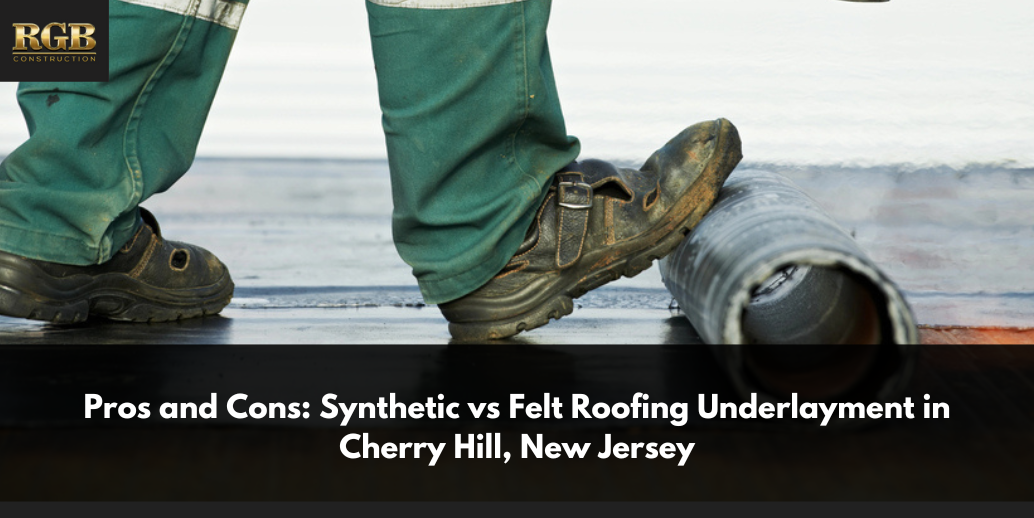When you think of a roof, you probably envision the shingles that go on it. However, there is more to a roofing system than the shingles. Being that the roof is indeed a system, it is composed of things like flashing, gutters, and something called underlayment, a barrier that keeps the roof deck from getting saturated. For New Jersey homeowners in Cherry Hill, it is important to know what kind of underlayment your roofing contractor uses—felt vs synthetic—as well as what that can mean for your roof and warranty. Let’s discuss.
Key Takeaways
- Underlayment serves as an additional barrier against moisture, protecting the roof deck from saturation caused by rain, snow, and wind.
- Crafted from paper or fiberglass mat saturated with asphalt, felt underlayment is cost-effective but prone to tearing, moisture absorption, and potential warranty issues.
- Made from durable polymers, synthetic underlayment offers superior tear strength, fast installation, slip-resistant surfaces, and moisture resistance, though it comes with a higher upfront cost.
- Manufacturers may require specific underlayment types to maintain warranty coverage, with synthetic often being preferred.
What is Underlayment?
Underlayment refers to a layer of material installed directly on top of the roof deck and beneath the outer roof covering, such as asphalt shingles. It serves as an additional barrier against moisture, providing protection from rain, snow, and wind.
There are two types of roof underlayment commonly seen in New Jersey: felt and synthetic underlayment. Each type has pros and cons that need to be understood and carefully weighed.
What is Felt Roofing Underlayment?
Felt roofing underlayment stands as one of the oldest varieties, crafted by saturating paper or fiberglass mat with asphalt. It typically comes in two types: No. 15 felt and No. 30 felt. While No. 30 felt is thicker and stronger, offering better resistance to tearing, both options come with their own set of pros and cons.
Pros of Felt Underlayment
- Cost-effective, making it appealing to budget-conscious homeowners.
Cons of Felt Underlayment
- Susceptible to tearing in high winds and during installation.
- May absorb moisture, causing wrinkling and potential complications during shingle installation.
- Heavier and more challenging to maneuver during installation.
- May void manufacturer warranties when used.
What is Synthetic Roofing Underlayment?
Felt is an obsolete selection in many cases, which is why synthetic roof underlayment is now being chosen more frequently by professional roofing contractors, like those at RGB Construction. Synthetic materials provide enhanced water resistance and durability when compared to felt. Typically, synthetic roofing underlayment is made of long-lasting polyers, offering superior strength and longevity.
Pros of Synthetic Underlayment
- Tough and durable, with high tear strength.
- Fast to install, reducing labor time.
- Safe, featuring slip-resistant surfaces for enhanced walkability.
- Moisture-resistant, preventing water infiltration.
Cons of Synthetic Underlayment
- Higher upfront cost compared to felt.
How Does Synthetic vs Felt Roofing Underlayment Compare?
Synthetic and felt roofing underlayment both serve as secondary layers of protection beneath the roof covering, but they differ in material composition, performance, and installation characteristics.
Felt underlayment is traditionally made by saturating paper or fiberglass mat with asphalt, while synthetic underlayment is crafted from long-lasting polymers, often plastics or polyethylene.
In terms of how these materials perform, synthetic is the winner. Synthetic roof underlayment provides more durability and resilience in harsh weather conditions. Furthermore, synthetic roofing underlayment is moisture-resistant. Felt, on the other hand, has a tendency to absorb moisture when exposed to it, often leading to installation issues.
During installation, felt underlayment is heavier and can be more challenging to handle compared to synthetic underlayment, which is lighter and easier to maneuver. Synthetic underlayment often comes in wider and longer rolls, resulting in faster installation and fewer trips up the ladder for roofers. Moreover, synthetic underlayment may feature slip-resistant surfaces and clear markings for easier and safer installation, while felt underlayment may have a slippery surface.
Which Roof Underlayment is Right for Your Cherry Hill, NJ Home?
Ultimately, the choice between synthetic and felt roofing underlayment depends on factors such as budget, climate, roof design, and desired level of protection. Synthetic underlayment often offers superior performance and ease of installation, making it a preferred choice for many roofing projects despite its higher initial cost.
Do not forget to ask a trusted roofing contractor like RGB Construction about the kind of roofing underlayment used during the installation process and what materials are available. A roofing contractor can provide valuable insight based on their experience.
Lastly, keep in mind that manufacturers may specify the type of underlayment needed to maintain warranty coverage. Synthetic underlayment may be required by certain roofing material manufacturers to ensure warranty protection.
Contact a Cherry Hill Roofing Contractor Today About Your Roof!
Both felt and synthetic roofing underlayment are options available to homeowners. That said, synthetic underlayment tends to provide homeowners in Cherry Hill, NJ with far more advantages when compared to felt. Contact a trusted roofing contractor like RGB Construction today to learn more about underlayment and which is best for your home. RGB Construction has over two decades of experience aiding homeowners like you with not only resolving roofing issues but getting more longevity out of their roofs.
Reach us at 856-264-9093 or by filling out the online form and learn more about what we can do for you.







